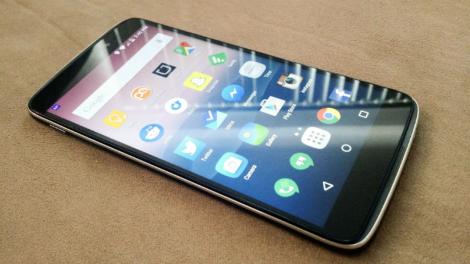
Introduction, design and display
Two years ago, if you would have told me you could buy an Android phone with flagship-worthy specs for under $300 unlocked, I would have said you’re crazy. And, I would have assumed you hijacked a semi trailer full à la Fast and the Furious. However, this is 2015, and Alcatel has managed to deliver exactly that with the Alcatel OneTouch Idol 3.
Available in the US for $250 (£270, about AU$328) unlocked, it rests on the same spectrum as the Asus ZenFone 2, and OnePlus One. While you’ve probably heard of the latter, don’t let the Idol 3’s innocuous name fool you. It’s rolled up to the party ready to have some fun.
With a 5.5-inch, 1080p IPS display, it’s got the same pixel density as the iPhone 6 Plus. A 1.5GHz Qualcomm Snapdragon 615 octa-core processor and 2GB of RAM are tucked inside, along with 16GB of internal storage. If 10GB of actually useable storage isn’t enough for you, there’s microSD card support for up to 128GB. On the back is a 13-megapixel (MP) camera with a single LED flash, and on the front is a crazy 8MP snapper. Theoretically, selfies should be amazing.
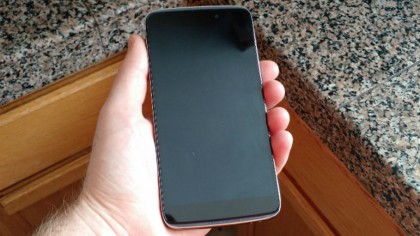
From NFC to LTE support, it’s got all the connectivity you’d expect, including dual-band Wi-Fi, and a 2,910 mAh battery keeps the juice flowing. In the sound department, dual front-facing speakers created in partnership with JBL liven things up.
Design
The Alcatel OneTouch Idol 3 is not the Brad Pitt of smartphones. Nothing from the plastic body particularly jumps out at you, but it’s not terrible to look at either. At 7.4mm thin, it’s only slightly thicker than some of the latest flagships, and its rounded edges are wrapped in faux metal.
The fake metal edges are very reminiscent of the Samsung Galaxy S5, and offer a good amount of grip. On the top, you have a microphone and headphone jack, and on the bottom is another microphone and micro USB charging port.
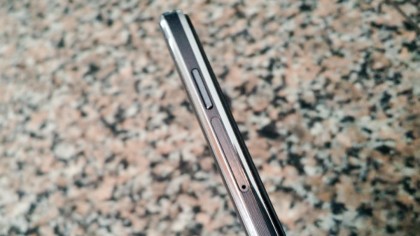
On the left-hand side, at the very top, is the power button and SIM card slot, and also at the top on the right-hand side are the volume buttons. You may be wondering, where the microSD card slot is located? There isn’t one, actually. Instead, Alcatel incorporated it into the SIM card slot.
Because of the 5.5-inch display, the power and volume buttons could have been better positioned together on the right-hand side halfway down. Despite having big hands, they were sometimes difficult to get to.
The brushed plastic back has a smooth, but not slippery feel to it, and features “Idol” and “Alcatel OneTouch” branding. My review unit had some FCC stickers, but thankfully those won’t be included on the production model. The 13MP rear-facing camera is completely flush with the back – unlike some of the latest flagships in their pursuit to get even thinner – and it gets the same faux metal treatment.
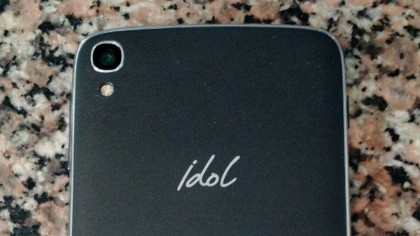
At just under five ounces, the Idol 3 feels solid in my hand. It’s not too heavy, not too light. Personally, I’d rather have a phone that feels solid than one insanely thin and light. The Idol 3 reaffirms this. I never had a fear of dropping it, even while jogging, and coming from the 5.2-inch display on the Moto X, it took very little adjusting.
It’s possible to use one-handed, and is well-balanced enough to not topple over. The body and display do offer a little bit of flex, and you can tuck away in your pocket no problem.
Sticking out just a few millimeters on the top and bottom beyond the display are the dual front-facing speakers. They actually sit below the glass panel of the display, creating a small but noticeable drop off.
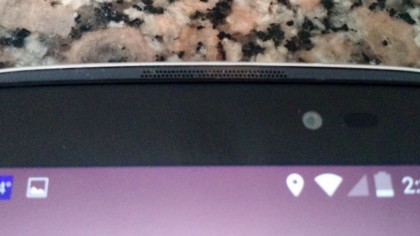
If you want something other than the ordinary black or white, you’ll be left hanging. At launch, the Idol 3 is only available in dark gray. Alcatel will offer a flip case starting May 30, but it too will be available in the same bland color.
Display
While LG and Samsung want you to believe you need Quad HD in your life, the reality is, 1080p is perfectly suitable for the average person. Even at 5.5-inches, there’s no issue with seeing individual pixels. Being an IPS LCD panel, colors are fairly accurate, and the screen gets sufficiently bright even when the sun is glaring down on you.
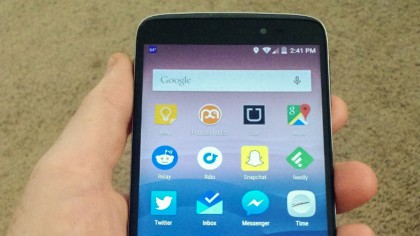
Bezels are fairly thin on the sides, and about half an inch on the top and bottom. This is to make way for the 8-megapixel front-facing camera, and dual stereo speakers which we’ll get into here shortly.
Interface and performance
A lot of manufacturers like to add their own skin on top of Android. For the purists out there, it can be a major annoyance, and in quite a few cases, actually slows the phone down. In the case of the Idol 3, Alcatel kept it simple. The phone is running virtually stock Android Lollipop, and here’s a list of pre-installed apps:
- Evernote
- Adobe Reader
- WPS Office
- Dropbox
- AVG Anti-Virus
- Radio
- Weather
- Compass
- Mix (music player)
- Notes
- Sound Recorder
- Tags (NFC)
- Wi-Fi Display
- Wi-Fi Transfer
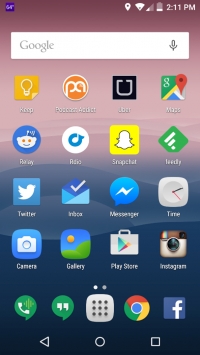
You can completely uninstall third-party apps like Facebook and AVG, but can’t do so with the generic system apps. Of course, Google’s usual suite of Play-branded apps are installed, along with Gmail, Chrome, Hangouts, Calendar, Email and more.
From a visual standpoint, most of what’s been changed are the app icons themselves. The notifications drawer and quick settings menu has kept its Android 5.0 Lollipop roots. You can easily access quick settings by swiping down from the top with two fingers, and a gear icon takes you directly to Settings. And, because Lollipop allows multiple user accounts, you can tap the avatar to switch to another account.
On paper, the Idol 3 should scream through whatever you throw at it. After all, it has an octa-core processor and 2GB RAM. However, it’s yet another reminder that optimized software is just as, if not more important, than great hardware. The “buttery smooth” first introduced in Android 4.1 Jelly Bean just isn’t here. Scrolling can be a bit janky, and there’s sometimes as much as a two second delay when opening or transitioning to other apps.
Navigating around the home screen and app drawer seems to be okay, though. To try and fix the lag, I enabled Developer Options, and turned off all animations. This definitely helped to speed things up, but is far from ideal.
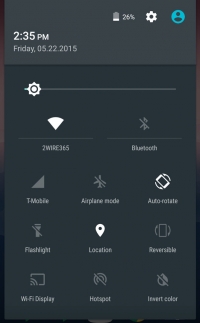
In Geekbench, the Idol 3’s multi-core score was 2066. This puts it just behind the Exynos octa-core version of the Samsung Galaxy S4, and nearly 800 points behind the Asus Zenfone 2.
The phone I tested was running Android 5.0.2, which is known to have performance issues. We reached out to Alcatel to find out if an update to Android 5.1 is planned, and will update this review once we hear back.
On the plus side, if you’re one of the few who still use a phone to make phone calls, the Idol 3 offers no complaints. In fact, when talking with my dad, he said it “sounds like you’re sitting right next to me.”
Reversible
When the OneTouch Idol 3 was announced back at MWC 2015, it was touted as the world’s first “reversible” smartphone. Basically, even if the phone is upside down, you can use it as you normally would.
The display automatically adjusts as long as you have the “Reversible” icon selected under quick settings. It’s a great idea. After all, how many times have you pulled your phone out of your pocket, and had to flip it right side up? I found myself taking advantage of it on a few occasions, but muscle memory usually kicked in.
Dual stereo speakers
When HTC launched the One, front-facing speakers were one of those incredibly simple, yet brilliant ideas. Alcatel apparently agreed, and teamed up with JBL to offer a similar experience.
The audio is crisp, and as someone who enjoys listening to podcasts in the morning while getting my day going, it’s fantastic. Music doesn’t sound 100%, and is missing some detail, but I don’t expect perfection from such tiny speakers.
However, don’t let the word “tiny” fool you. These speakers pack some serious punch. I quickly learned you’ll want to keep the volume for notifications around ⅓ of the way, otherwise you may jump when you’re “in the zone” working. And if you’re going to talk to someone on speakerphone, you best not do it in a crowded public place. While the speakers do add a bit more to the bezel, it’s a welcome trade-off.
Camera, battery life and verdict
Full-size photos: https://drive.google.com/folderview?id=0B5iOZICiywWQfnljM0NESVYzaXdHZFRoNkktd0VUVnR4N1dURjF1Q09XdjZrSlJDVEtUcWs&usp=sharing
I snap photos just as much as the next guy or gal, so it’s safe to say a bad experience can be a deal breaker. The 13MP camera features a Sony sensor, and it performed as I’d expected with good quality. For a $250 (£270, about AU$328) phone, it’s hard to complain.
Photos take a second or two to focus, and about the same to snap. Shooting with the default camera app, it was a little confusing at first since there’s no visual feedback once you’ve taken a photo. I’ve never owned a phone that shoots great in low-light, and the Idol 3 was no exception.
The real star is the 8MP front-facing camera. With the right lighting, you can capture some pretty great selfies. Of course, it might help to have a better subject than me.

It’s worth noting that, by default, the rear camera shoots 10MP photos to allow for a wide 16:9 ratio. While Alcatel advertises an “8MP Wide Angle Front Camera,” you’ll actually have to drop down to 5-MP to get that wide shot. Still, the results can be pretty impressive, and you can shoot 1080p video as well.
The camera app keeps the Android Lollipop feel, but with a few additions. Swiping from the left, you’re met with several options:
- Auto mode
- HDR
- Pano
- Manual mode
- Time-lapse
- Scanner
- Face Beauty
I mostly stuck with the default auto mode, though HDR and Pano – otherwise known as panorama – performed well. Unfortunately, for those who know all about ISO and want a little more control over their shots, the camera app would crash in Manual mode whenever I tried changing the shutter priority (S) or white balance (WB).
Although Manual mode didn’t pan out (no pun intended), the Time-lapse feature worked great. Here’s a result I uploaded to Instagram.
If you’re one of the four people who scan QR codes, the Scanner function is pretty straightforward. As you probably guessed by now, Face Beauty is all about capturing that perfect selfie.
Utilizing the built-in face detection, you can smooth out any blemishes with this feature. I took three separate photos, the first in Auto mode. The other two were in Face Beauty with the slider set to halfway in one, and to the max in another.

With the slider set to halfway, it did a pretty good job. However, when set to the max, the fake glow and smoothness is blatantly obvious. Quick side note: just be yourself and let the real you shine through.
Battery life
During my testing, I kept the screen at auto brightness, and GPS at high accuracy. Under moderate use, the 2,910 mAh battery performed extremely well. I was able to consistently get about 20 hours with around 25% battery left. This was with about 3 hours of screen on time, and I could have easily squeezed out another hour with some juice to spare.
Under heavy use, you could definitely get through a work day. In our battery rundown test where we loop video at 100% brightness, from a full charge the Idol 3 lasted 4 hours, 55 minutes. Sadly, the Idol 3 does not have Quick Charge support, and comes with a standard charger. Alcatel’s claim of two and a half hours is about right if the phone is nearly dead, and from around 25% battery, it took about 90 minutes to fully charge.
We liked
The Full HD display is on the same level as other 1080p panels in more expensive phones. Dual front-facing speakers should be standard on every device, and the 8MP front-facing camera is truly at the top of its class. Alcatel doesn’t claim 24 hour battery life, but it’s possible under the right circumstances.
We disliked
Performance issues are what’s really holding the Idol 3 back from 4.5 stars. The fact it’s only available in gray takes some life away, and while Quick Charge support isn’t necessary, it’s tough living without once you’ve been spoiled.
Final verdict
The Alcatel OneTouch Idol 3 has all the bells and whistles at a fraction the cost of major flagships. It’s no flagship killer, but it’s also not claiming to be. While good, good isn’t always enough.
With the performance issues ironed out, there’s no doubt the Idol 3 could be great. There’s also the issue of carrier compatibility. Support for GSM and UTMS bands means you’re stuck with AT&T and T-Mobile in the US.
Still, we’re talking $250 (£270, about AU$328) unlocked. The fact the OneTouch Idol 3 even exists is pretty amazing. If you’re willing to live with some imperfections for an excellent price, there’s no reason this phone can’t be good enough for you.
![]()
Related Posts
December 6, 2021
7+ Web Design Trends for 2022: Which Will You Use?
December 6, 2021
The 10 Best WordPress Booking Plugins to Use On Your Website
December 6, 2021
How to Use a Web Cache Viewer to View a Cached Page
November 6, 2021
10 Modern Web Design Trends for 2022
November 6, 2021
Best Free SSL Certificate Providers (+ How to Get Started)
November 6, 2021
How to Design a Landing Page That Sends Conversions Skyrocketing
November 6, 2021
What Are the Best WordPress Security Plugins for your Website?
October 6, 2021
Your Guide to How to Buy a Domain Name
October 6, 2021
How to Build a WordPress Website: 9 Steps to Build Your Site
September 6, 2021
10 Best Websites for Downloading Free PSD Files
September 6, 2021
HTML5 Template: A Basic Code Template to Start Your Next Project
September 6, 2021
How Much Does It Cost to Build a Website for a Small Business?
September 6, 2021
A List of Free Public CDNs for Web Developers
September 6, 2021
6 Advanced JavaScript Concepts You Should Know
August 6, 2021
10 Simple Tips for Launching a Website
August 6, 2021
25 Beautiful Examples of “Coming Soon” Pages
August 6, 2021
10 Useful Responsive Design Testing Tools
August 6, 2021
Best-Converting Shopify Themes: 4 Best Shopify Themes
July 6, 2021
What Is Alt Text and Why Should You Use It?
July 6, 2021
24 Must-Know Graphic Design Terms
June 6, 2021
How to Design a Product Page: 6 Pro Design Tips
April 6, 2021
A Beginner’s Guide to Competitor Website Analysis
April 6, 2021
6 BigCommerce Design Tips For Big Ecommerce Results
April 6, 2021
Is WordPress Good for Ecommerce? [Pros and Cons]
March 6, 2021
Make Websites Mobile-Friendly: 5 Astounding Tips
March 6, 2021
Shopify vs. Magento: Which Platform Should I Use?
March 6, 2021
Top 5 Web Design Tools & Software Applications
February 6, 2021
Website Optimization Checklist: Your Go-To Guide to SEO
February 6, 2021
5 UX Design Trends to Dazzle Users in 2021
February 6, 2021
What Is the Average Page Load Time and How Can You Do Better?
February 6, 2021
Choosing an Ecommerce Platform That Will Wow Customers
February 6, 2021
7 Best Practices for Crafting Landing Pages with Forms
February 6, 2021
7 B2B Web Design Tips to Craft an Eye-Catching Website
January 6, 2021
Mobile-Friendly Checker | Check Your Site’s Mobile Score Now
January 6, 2021
8 Tips for Developing a Fantastic Mobile-Friendly Website
December 6, 2020
How to Add an Online Store to Your Website [4 Ways]
December 6, 2020
5 UX Design Tips for Seamless Online Shopping
November 6, 2020
Ecommerce Website Essentials: Does Your Site Have All 11?
November 6, 2020
5 Small Business Website Essentials You Need for Your Site
November 6, 2020
Your Website Redesign Checklist for 2020: 7 Steps for Success
May 1, 2020
Psychology of Color [Infographic]
April 21, 2020
How to start an online store that drives huge sales
January 3, 2020
5 Lead Generation Website Design Best Practices
March 6, 2019
6 Reasons You Should Redesign Your Website in 2019
March 6, 2019
7 Web Design Trends for 2019
February 19, 2019
Who owns the website/app source code, client or developer
February 7, 2019
Don’t Let Your Domain Names Expire in 2019
January 8, 2019
2019 Website Development Trends To Note
October 6, 2017
How Web Design Impacts Content Marketing
October 6, 2017
How to Choose a Navigation Setup
August 6, 2017
Why User Experience Matters to Marketing
July 6, 2017
5 Ways Web Design Impacts Customer Experience
September 6, 2016
How to Learn Angular
September 6, 2016
The Excuses for Not Having a Website (Infographic)
September 6, 2016
How to Build an Award-Winning Web Design Team
September 6, 2016
13 Free Data Visualization Tools
August 6, 2016
How Selling Pastries Helped Us Design a Better Product
August 6, 2016
11 Sites to Help You Find Material Design Inspiration
July 4, 2016
How to change free wordpress.com url
April 6, 2016
The 5 Best Free FTP Clients
April 6, 2016
7 Free UX E-Books Worth Reading
March 6, 2016
Can Handwritten Letters Get You More Clients?
December 10, 2015
Star Wars Week: How to create your own Star Wars effects for free
December 6, 2015
20 "Coming Soon" Pages for Inspiration
December 6, 2015
6 Free Tools for Creating Your Own Icon Font
December 6, 2015
9 Useful Tools for Creating Material Design Color Palettes
November 6, 2015
20 Free UI Kits to Download
November 6, 2015
50 Web Designs with Awesome Typography
November 6, 2015
When to Use rel="nofollow"
November 6, 2015
7 Free Books That Will Help You Become More Productive
November 6, 2015
50 Beautiful One-Page Websites for Inspiration
November 6, 2015
Circular Images with CSS
October 6, 2015
Lessons Learned from an Unsuccessful Kickstarter
October 6, 2015
5 Games That Teach You How to Code
October 6, 2015
Cheatsheet: Photoshop Keyboard Shortcuts
October 6, 2015
An Easy Way to Create a Freelance Contract for Your Projects
October 6, 2015
50 Design Agency Websites for Inspiration
September 29, 2015
JB Hi-Fi shutting the book on ebooks
September 24, 2015
Opinion: Quick, Quickflix: It's time to give yourself the flick
September 24, 2015
New Star Wars 360-degree video is among first on Facebook
September 21, 2015
Apple purges malicious iPhone and iPad apps from App Store
September 12, 2015
Apple's new Live Photos feature will eat up your storage
September 12, 2015
The latest Windows 10 Mobile preview has been delayed
September 12, 2015
IBM buys StrongLoop to add Node.js development to its cloud
September 8, 2015
Fake Android porn app takes your photo, then holds it ransom
September 6, 2015
50 Restaurant Websites for Inspiration
September 6, 2015
Zero UI — The Future of Interfaces
September 6, 2015
50 Beautiful Websites with Big Background Images
September 6, 2015
Infographic: 69 Web Design Tips
September 6, 2015
Free Windows 10 Icons
September 2, 2015
Instagram turns itself into a genuine messaging service
August 11, 2015
In Depth: How Microsoft taught Cortana to be more human
August 11, 2015
Windows 10 price, news and features
August 11, 2015
Windows 10's broken update introduces endless reboot loop
August 11, 2015
Windows 10 races to 27m installs
August 11, 2015
Windows 10 IoT Core gets first public release
August 10, 2015
iOS Tips: How to backup iPhone to an external drive
August 10, 2015
Windows 8.1 RT finally getting Windows 10 Start Menu
August 10, 2015
How to use Windows Hello
August 10, 2015
Review: Moto Surround
August 10, 2015
Review: Moto G (2015)
August 9, 2015
8 of the best free VPN services
August 8, 2015
Use Firefox? Mozilla urges you update ASAP
August 7, 2015
Mac Tips: Apple Mail: How to remove the Favorites Bar
August 7, 2015
How to make the OS X dock appear faster
August 7, 2015
Review: BQ Aquaris E45 Ubuntu Edition
August 7, 2015
Review: Acer Liquid Jade Z
August 6, 2015
How to reinstall Linux
August 6, 2015
How to reinstall Windows
August 6, 2015
Updated: Apple Music: release date, price and features
August 6, 2015
Social News Websites for Front-End Developers
August 6, 2015
10 Free JavaScript Books
August 6, 2015
50 Beautiful Blog Designs
August 6, 2015
Animated SVG Pipes Effect
August 6, 2015
Launching Your First App
August 5, 2015
Windows 10 goes freemium with paid apps
August 5, 2015
Updated: Week 1 with Windows 10
August 5, 2015
Mac Tips: How to manage Safari notifications on Mac
August 5, 2015
Microsoft Sway may kill the PowerPoint presentation
August 4, 2015
Microsoft gives Outlook on the web a new look
August 4, 2015
Mac OS X vulnerable to new zero-day attack
August 4, 2015
Windows 10 users warned of two scams
August 4, 2015
Microsoft's Docs.com is now available to everyone
August 3, 2015
Mac Tips: How to edit the Favorites sidebar on Mac
August 3, 2015
Updated: Windows 10 price, news and features
July 29, 2015
Review: HP ProDesk 405 G2
July 29, 2015
Hands-on review: HP Elite x2 1011
July 29, 2015
Hands-on review: Updated: Windows 10 Mobile
July 29, 2015
Review: Updated: Nvidia Shield Android TV
July 28, 2015
LIVE: Windows 10 launch: Live Blog!
July 28, 2015
How to prepare for your upgrade to Windows 10
July 28, 2015
Review: Updated: Windows 10
July 28, 2015
Review: Updated: HP Pro Tablet 608
July 28, 2015
Review: Heat Genius
July 28, 2015
Hands-on review: Moto X Play
July 28, 2015
Hands-on review: Moto X Style
July 28, 2015
Hands-on review: Moto G (2015)
July 28, 2015
Review: 13-inch MacBook Air (early 2015)
July 28, 2015
Hands-on review: OnePlus 2
July 28, 2015
Review: LG 65EG960T 4K OLED
July 28, 2015
Mac Tips: How to share printers on Mac
July 27, 2015
Apple Music's arrival hasn't opened Pandora's box
July 26, 2015
Review: Garmin Swim
July 25, 2015
How to merge OS X contacts into an existing list
July 25, 2015
Hands-on review: UPDATED: ZTE Axon
July 24, 2015
Mac Tips: How to zoom in on a Mac
July 24, 2015
What Windows 10 means for the enterprise
July 24, 2015
Review: JBL Charge 2 Plus
July 24, 2015
Review: Acer Aspire S7
July 24, 2015
Review: Updated: Canon G3 X
July 24, 2015
Review: Updated: iPad Air 2
July 24, 2015
Review: Thinksound On1
July 24, 2015
Review: Asus Chromebook Flip
July 24, 2015
Review: Garmin Forerunner 225
July 23, 2015
Review: Garmin nuvi 68LM
July 23, 2015
Review: Samsung Galaxy S6 Active
July 23, 2015
Review: Bowers and Wilkins P5 Wireless
July 23, 2015
Review: Dell XPS 15 (2015)
July 21, 2015
Review: Fuji S9900W
July 21, 2015
Review: Updated: Fitbit Surge
July 21, 2015
Review: UE Roll
July 21, 2015
Hands-on review: Ubik Uno
July 20, 2015
Review: Samsung HW-J650
July 20, 2015
Updated: 40 best Android Wear smartwatch apps 2015
July 20, 2015
Review: Acer Chromebook C740 review
July 20, 2015
Review: Huawei Talkband B2
July 20, 2015
Review: Dell Venue 10 7000
July 20, 2015
Review: Intel Core i7-5775C
July 17, 2015
Mac Tips: How to delete locked files on Mac
July 17, 2015
Review: Pebble Time
July 16, 2015
Microsoft just made Windows XP even less secure
July 16, 2015
Windows 8.1 RT is getting an update this September
July 16, 2015
OS showdown: Windows 10 vs Windows 8.1 vs Windows 7
July 16, 2015
Review: Acer CB280HK
July 15, 2015
Windows 10 is ready for new laptops and PCs
July 15, 2015
Explained: How to take a screenshot in Windows
July 15, 2015
Office for Windows 10 appears in latest build
July 14, 2015
Review: ZTE Axon
July 14, 2015
Review: ViewSonic VP2780-4K
July 14, 2015
Hands-on review: SanDisk Connect Wireless Stick
July 14, 2015
Review: Oppo PM-3
July 14, 2015
Review: BT 11ac Dual-Band Wi-Fi Extender 1200
July 14, 2015
Review: Fuji X-T10
July 13, 2015
How to build an SEO strategy for your business
July 13, 2015
Review: Lenovo ThinkPad Yoga 15
July 13, 2015
Review: Audio-Technica ATH-MSR7
July 13, 2015
Review: Garmin NuviCam LMT-D
July 13, 2015
Review: Dell Inspiron 13 7000
July 13, 2015
Hands-on review: AstroPi SenseHAT
July 13, 2015
Hands-on review: EE Rook
July 13, 2015
Hands-on review: Updated: HTC Vive
July 12, 2015
Here's the ultimate software list for PC fanatics
July 10, 2015
How to use the new Photos app for Mac
July 10, 2015
Windows 10 Insider Preview Build 10166 available now
July 10, 2015
Splunk spends big on cybersecurity acquisition
July 10, 2015
Making Windows 10 apps just got a whole lot easier
July 10, 2015
Review: Lenovo LaVie Z 360
July 9, 2015
OS X El Capitan public beta available right now
July 9, 2015
Microsoft finally unveils Office 2016 for Mac
July 9, 2015
Review: Updated: Chromecast
July 9, 2015
Review: Updated: Tesco Hudl 2
July 9, 2015
Review: Lenovo ThinkPad E550
July 9, 2015
Review: Updated: Google Nexus 6
July 8, 2015
What you need to know about Windows Server 2016
July 7, 2015
Microsoft to hike enterprise cloud pricing
July 6, 2015
Hacking Team end up being totally 0wned
July 6, 2015
Review: HP Pro Slate 12
July 6, 2015
Review: Samsung 850 Pro 2TB
July 6, 2015
Review: Asus RT-AC87U
July 6, 2015
Review: Jawbone UP2
July 6, 2015
Reimagining the Web Design Process
July 6, 2015
50 Clean Websites for Inspiration
July 6, 2015
15 Free Books for People Who Code
July 6, 2015
Web Storage: A Primer
July 6, 2015
A Look at Some CSS Methodologies
July 3, 2015
6 Essential Mac Mouse and Trackpad Tips
July 2, 2015
How to install a third party keyboard on Android
July 2, 2015
Review: UPDATED: Asus Zenfone 2
July 2, 2015
Review: Alienware 13
July 2, 2015
Review: HP DeskJet 1010
July 1, 2015
5 issues we want Apple Music to fix
June 13, 2015
Cortana will get its own button on Windows 10 PCs
June 12, 2015
Windows 10 will come with universal Skype app
June 12, 2015
iPad music production: 18 Best apps and gear
June 12, 2015
Windows 10 all set for early enterprise struggle
June 12, 2015
Review: Garmin VIRB Elite
June 11, 2015
Review: Updated: Nvidia Shield Tablet
June 11, 2015
Review: Nokia Lumia 635
June 10, 2015
Microsoft brings more online tweaks to Office 365
June 10, 2015
Mac Tips: How to use Screen Sharing in Mac OS X
June 9, 2015
Hands-on review: Meizu M2 Note
June 9, 2015
Hands-on review: EE 4GEE Action Camera
June 9, 2015
Review: Toshiba 3TB Canvio external hard drive
June 9, 2015
Review: Olympus SH-2
June 8, 2015
Hands-on review: Updated: Apple CarPlay
June 8, 2015
UPDATED: iOS 9 release date, features and news
June 8, 2015
Review: Updated: Roku 2
June 8, 2015
Review: Updated: PlayStation Vue
June 8, 2015
Review: Dell PowerEdge R730
June 8, 2015
Review: Canon SX710 HS
June 7, 2015
UPDATED: iOS 9 release date, features and rumors
June 7, 2015
Review: Lenovo S20-30
June 6, 2015
Free Writing Icons
June 6, 2015
15 CSS Questions to Test Your Knowledge
June 6, 2015
The Best CSS Reset Stylesheets
June 6, 2015
How CSS Specificity Works
June 5, 2015
'Delay' is a new feature in Windows 10
June 5, 2015
Review: Beyerdynamic Custom One Pro Plus
June 5, 2015
Latest SEO Marketing tools
June 5, 2015
Review: Nvidia Shield Android TV
June 5, 2015
Review: Honor 4X
June 5, 2015
Review: In Depth: Oppo R5
June 3, 2015
Hands-on review: Huawei P8 Lite
June 3, 2015
How To: How to create eBooks on a Mac
June 3, 2015
Review: Updated: Tidal
June 3, 2015
Review: Canon 750D (Rebel T6i)
June 2, 2015
Review: Updated: Asus ZenWatch
June 2, 2015
Review: Updated: Nokia Lumia 1520
June 2, 2015
Review: Updated: Yotaphone 2
June 2, 2015
Review: Updated: Nokia Lumia 625
June 2, 2015
Review: Creative Muvo Mini
June 1, 2015
Review: Acer TravelMate P645 (2015)
June 1, 2015
Hands-on review: Corsair Bulldog
May 29, 2015
In Depth: NetApp: a requiem
May 29, 2015
July is looking definite for Windows 10 release
May 29, 2015
Hands-on review: Google Photos
May 28, 2015
Mac Tips: The 16 best free GarageBand plugins
May 28, 2015
Review: Canon 760D (Rebel T6s)
May 27, 2015
Review: Lenovo Yoga 3 14
May 27, 2015
Hands-on review: Serif Affinity Photo
May 27, 2015
Review: Garmin Vivoactive
May 26, 2015
Review: Datacolor Spyder5 Elite
May 26, 2015
Hands-on review: Sony Xperia Z3+
May 26, 2015
Review: Epson BrightLink Pro 1410Wi
May 26, 2015
Review: Technics Premium C700
May 26, 2015
Review: Canon EOS M3
May 26, 2015
Review: Updated: HTC One M9
May 26, 2015
Review: Updated: Sony Xperia Z3 Compact
May 25, 2015
Review: Updated: New Nintendo 3DS
May 25, 2015
Updated: 50 best Mac tips, tricks and timesavers
May 25, 2015
Updated: Windows email: 5 best free clients
May 25, 2015
Instagram is planning to invade your inbox
May 25, 2015
Review: Updated: Foxtel Play
May 24, 2015
How Windows 10 will change smartphones forever
May 24, 2015
Review: Vodafone Smart Prime 6
May 24, 2015
Review: Updated: iPad mini
May 22, 2015
Office Now may be Cortana for your work life
May 22, 2015
Review: Updated: Lenovo Yoga 3 Pro
May 22, 2015
Review: Microsoft Lumia 640 LTE
May 22, 2015
Review: Updated: Fitbit Flex
May 21, 2015
Updated: Best free Android apps 2015
May 21, 2015
Review: Asus ZenBook Pro UX501
May 21, 2015
Review: Sennheiser Momentum In-Ear
May 20, 2015
Hands-on review: UPDATED: Asus Zenfone 2
May 20, 2015
OS X 10.11 release date, features and rumors
May 18, 2015
Updated: Best free antivirus software 2015
May 18, 2015
iPhone 6S rumored to launch as soon as August
May 18, 2015
Microsoft ready to pounce and acquire IFS?
May 17, 2015
5 of the most popular Linux gaming distros
May 16, 2015
Review: Acer Chromebook 15 C910
May 16, 2015
Review: Lenovo ThinkPad X1 Carbon (2015)
May 16, 2015
Review: Polk Nue Voe
May 16, 2015
The top 10 data breaches of the past 12 months
May 16, 2015
Hands-on review: Updated: LG G4
May 16, 2015
Review: Updated: Quickflix
May 16, 2015
Review: LG Watch Urbane
May 16, 2015
Review: Razer Nabu X
May 16, 2015
Hands-on review: Updated: Windows 10
May 16, 2015
Review: UPDATED: Moto X
May 16, 2015
Review: Updated: Moto G (2013)
May 12, 2015
Review: TomTom Go 50
May 12, 2015
Review: Updated: Moto G (2014)
May 12, 2015
Review: Garmin Vivofit 2
May 12, 2015
Review: Asus Transformer Book Flip TP300LA
May 11, 2015
Review: MSI GT80 Titan
May 11, 2015
Review: Monster SuperStar BackFloat
May 9, 2015
Review: Updated: Apple Watch
May 7, 2015
5 million internet users infected by adware
May 7, 2015
Review: Updated: New MacBook 2015
May 6, 2015
Android M will be shown at Google IO 2015
May 6, 2015
Review: Epson WorkForce Pro WF-4630
May 6, 2015
Review: Master & Dynamic MH40
May 6, 2015
How to Use Gulp
May 6, 2015
Getting Started with Command-Line Interfaces
May 6, 2015
What It’s Like to Contribute to WordPress
May 6, 2015
Ultimate Guide to Link Types for Hyperlinks
May 6, 2015
11 Things You Might Not Know About jQuery
May 5, 2015
Hands-on review: Updated: PlayStation Now
May 5, 2015
Review: Lenovo ThinkPad Yoga 12
May 5, 2015
Review: Updated: iPad Air
May 5, 2015
Review: Panasonic SZ10
May 5, 2015
Review: Updated: Fetch TV
May 4, 2015
Review: Cambridge Audio Go V2
May 3, 2015
Review: Lightroom CC/Lightroom 6
May 2, 2015
5 of the most popular Raspberry Pi distros
May 1, 2015
Review: PlayStation Vue
May 1, 2015
Hands-on review: Updated: Microsoft HoloLens
April 30, 2015
Build 2015: Why Windows 10 may not arrive until fall
April 29, 2015
The biggest announcements from Microsoft Build 2015
April 29, 2015
Hands-on review: TomTom Bandit
April 29, 2015
Hands-on review: EE Harrier Mini
April 28, 2015
Review: Samsung NX500
April 28, 2015
Hands-on review: LG G4
April 28, 2015
Review: Patriot Ignite 480GB SSD
April 28, 2015
Hands-on review: EE Harrier
April 28, 2015
Review: Linx 10
April 28, 2015
Review: 1&1 Cloud Server
April 26, 2015
Hands-on review: Acer Iconia One 8
April 25, 2015
How to run Windows on a Mac with Boot Camp
April 24, 2015
Dropbox Notes poised to challenge Google Docs at launch
April 24, 2015
Hands-on review: Acer Aspire E14
April 24, 2015
Hands-on review: UPDATED: Valve Steam Controller
April 24, 2015
Review: Acer Iconia One 7
April 23, 2015
Windows 10 just revived everyone's favorite PC game
April 23, 2015
Google opens up Chromebooks to competitors
April 23, 2015
Here's how Outlook 2016 looks on Windows 10
April 23, 2015
Hands-on review: Updated: Acer Liquid M220
April 23, 2015
Hands-on review: Acer Aspire Switch 10 (2015)
April 23, 2015
Hands-on review: Acer Aspire R 11
April 22, 2015
Review: Alienware 17 (2015)
April 22, 2015
Hands-on review: Updated: HP Pavilion 15 (2015)
April 21, 2015
This is how Windows 10 will arrive on your PC
April 21, 2015
Review: iMac with Retina 5K display
April 21, 2015
Review: Epson XP-420 All-in-One
April 18, 2015
Google Now brings better search to Chrome OS
April 17, 2015
Review: Epson Moverio BT-200
April 17, 2015
Review: Pentax K-S2
April 16, 2015
Updated: Android Lollipop 5.0 update: when can I get it?
April 15, 2015
Hands-on review: Updated: Huawei P8
April 15, 2015
Review: SanDisk Ultra Dual USB Drive 3.0
April 15, 2015
Review: Updated: LG G3
April 15, 2015
Review: Updated: LG G3
April 15, 2015
Review: Crucial BX100 1TB
April 13, 2015
iOS 8.4 beta reveals complete Music app overhaul
April 13, 2015
Linux 4.0: little fanfare for a tiny new release
April 13, 2015
Achievement unlocked: Microsoft gamifies Windows 10
April 13, 2015
Best Android Wear smartwatch apps 2015
April 13, 2015
Review: Acer Aspire R13
April 12, 2015
Review: TP-Link Archer D9
April 10, 2015
Microsoft's new browser arrives for Windows 10 phones
April 10, 2015
Review: LG UltraWide 34UC97
April 9, 2015
Office now integrates with Dropbox on the web
April 9, 2015
Now you can buy video games with Apple Pay
April 9, 2015
Updated: iOS 8 features and updates
April 9, 2015
Microsoft's stripped down Nano Server is on the way
April 8, 2015
Skype Translator gets even more features
April 8, 2015
Windows mail services hit by widespread outages
April 8, 2015
Review: UPDATED: Amazon Echo
April 8, 2015
Hands-on review: Dell Venue 10 7000
April 8, 2015
Review: Updated: OS X 10.10 Yosemite
April 7, 2015
Google's GMeet could kill teleconferencing
April 7, 2015
Is Redstone the first Windows 10 update?
April 7, 2015
Next peek at Windows Server 2016 due next month
April 7, 2015
Review: Acer Aspire Switch 11
April 7, 2015
Review: Adobe Document Cloud
April 6, 2015
Hands-on review: Updated: New MacBook 2015
April 6, 2015
Freebie: 100 Awesome App Icons
April 6, 2015
Six Revisions Quarterly Report #1
April 6, 2015
A Modern Approach to Improving Website Speed
April 6, 2015
Disable Text Selection with CSS
April 4, 2015
Review: Nikon D7200
April 3, 2015
Amazon Prime video now streams to any Android tablet
April 3, 2015
Review: Google Cardboard
April 3, 2015
Review: MSI WS60
April 2, 2015
Chrome users can now run 1.3 million Android apps
April 2, 2015
See Windows 10 Mobile running on an Android handset
April 2, 2015
Review: Mini review: Macphun Noiseless Pro 1.0
April 2, 2015
Review: Intel SSD 750 Series 1.2TB
April 2, 2015
Review: BenQ TreVolo
April 2, 2015
Hands-on review: Nikon 1 J5
April 1, 2015
Microsoft launches Windows 10 music and video apps
April 1, 2015
Review: mini review: Sony XBA-H1
December 19, 2014
Review: CoPilot Premium sat nav app
December 19, 2014





























































































































































































































































































































































































































































































































































































